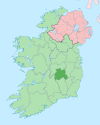Ballyhide
This article has multiple issues. Please help improve it or discuss these issues on the talk page. (Learn how and when to remove these template messages)
|
Ballyhide
Baile an Hídigh | |
|---|---|
Townland | |
IST (WEST)) | |
| Irish Grid Reference | S702742 |
Ballyhide (Irish: Baile an Hídigh, meaning "town of An tÍdeach (de la Hyde)")[1] is a rural townland and village in the extreme south eastern corner of County Laois, Ireland at the border with County Carlow. The nearest urban centre is Carlow town which is 3 kilometres to the north east. It is located in the Luggacurren Local Electoral District.
Demographics
As of the 2011 census, the townland of Ballyhide had a population of 163 people.[2] The most densely populated area of Ballyhide is a small village situated beside the River Barrow at the border with Crossneen, another local townland. Some of the population are employed in Carlow town, while others work in the Clogrennane Lime plant which is situated 2.5 kilometres to the south west.[citation needed] The area is agricultural, and dairying is the main farming enterprise.[citation needed]
Geography
Ballyhide townland is in the historic barony of Slievemargy.[3] It is bordered to the south by the River Barrow and the county boundary between County Laois and County Carlow, to the east by Crossneen and to the north by Springhill which are other townlands within the same parish. The River Fuishoge also runs through the area and is a tributary of the Barrow. The area lies at the foot of a 336m high hill referred to as Rossmore, Killeshin hill and often on maps as Slieve Margy.[citation needed]
Landmarks
The ruin of a mansion, often referred to locally as Rochfort's Castle or the Black Castle, sits at the foot of the hill overlooking Ballyhide. It was once owned by the Rochfort family, an
Ballyhide's location on the banks of the Barrow makes it a common fishing spot.[
Sport
There are two Gaelic football clubs in the area, Graiguecullen GAA and Killeshin GAA. Some Ballyhide people also use the sports facilities in or around Carlow town such as the Carlow Lawn Tennis Club or Carlow Golf Club or play soccer with Killeshin or with Graiguecullen based clubs St Patricks Boys FC or St Fiaccs FC.[citation needed]
Education
The local primary schools include Scoil Chomhgáin Naofa, Killeshin and St Fiaccs National School, Graiguecullen. Children may go on to study at second level in any of Carlows second level schools such as
See also
References
- ^ "Baile an Hídigh / Ballyhide". logainm.ie. Placenames Database of Ireland. Retrieved 15 January 2021.
- ^ "CD159 - Laois Population by Private Households, Occupied and Vacancy Rate by Townlands, CensusYear and Statistic". data.gov.ie. Central Statistics Office. Retrieved 15 January 2021.
- ^ "Ballyhide Townland, Co. Laois". townlands.ie. Retrieved 15 January 2021.

